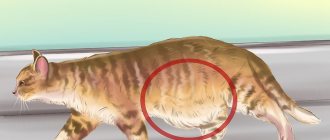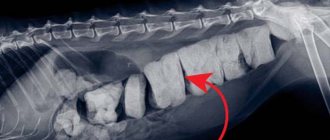Cat flu – a term used by veterinary specialists for diseases caused by pathogens of viral infections and accompanied by damage to the upper respiratory tract.
Like human flu epidemics, cat flu is a highly contagious disease affecting the cat family in a city, region, etc.
Which cat is most susceptible to the flu?
Considering the fact that feline influenza is one of the most common viral diseases among the cat family, it is almost always present in this animal population. Among cats, the most common cases of influenza are:
- Elderly cats and kittens over 2 months of age.
- Cats kept in nurseries, shelters, etc., where there are conditions for the rapid spread of influenza.
- Cats with reduced immunity (feline immunodeficiency virus, patients with leukemia).
- Not vaccinated against viral infectious diseases.
Is there cat flu?
Many cat owners wonder what cat flu is. This virus is not transmitted from humans; animals most often become infected from their relatives. Therefore, the disease is often transmitted between cats living in shelters. There are also other risk groups:
- cats without vaccines;
- kittens (due to weak immunity);
- older cats;
- cats whose immunity has been suppressed due to cancer or taking medications that affect the immune system.
The cause of influenza in cats is infection with the rhinotracheitis virus or calicivirus.
How does infection occur?
Can a kitten get infected with ARVI from a person? Cat flu most often occurs in cats that live outside, often walk there, or are in large numbers in one room. It is worth noting that kittens, as well as older cats, more often suffer from the disease, the same applies to pets with chronic pathologies and weakened immunity.
A cat can become infected through contact with other individuals through airborne droplets. As a rule, this happens when animals play together, eat or drink from the same container. The virus practically does not live in the air, deteriorating quite quickly, but there is a possibility that it can linger on toys, bedding, and combs.
Symptoms and treatment
The disease can be identified in a pet by a number of characteristic signs:
- heat;
- sneezing and coughing;
- profuse salivation and tear production;
- nasal discharge;
- lack of appetite;
- lethargy, weakness;
- in some cases - the formation of ulcers in the mouth.
If the owner observes at least one obvious symptom in his cat, it is necessary to go for an examination to a veterinarian - the doctor, based on the complaints, will prescribe tests and will soon be able to make a diagnosis.
If cat flu is confirmed, treatment should also be prescribed exclusively by a specialist.
Important!
Cat flu is significantly different from human flu, and any attempts to cure the animal on your own can not only delay recovery, but also aggravate the situation.
Depending on the pathogen, the flu in a cat can occur in different ways. When the disease was caused by a herpes virus infection, the clinical signs are more pronounced; the cat has conjunctivitis.
If the causative agent is a calicivirus infection, the disease is milder. However, small kittens with severe influenza may develop pneumonia, as well as passing arthritis.
Diagnostics
Influenza in cats is an upper respiratory tract disease.
The doctor, analyzing the signs, makes a conclusion about the diagnosis, but sometimes may prescribe additional tests. To conduct them, you need to collect samples of discharge from the eyes, as well as a sample of saliva.
The genes of the virus can also be detected at the molecular level using a special PCR test.
Treatment
The doctor prescribes medications aimed at fighting the infection and alleviating symptoms. The drugs must be given to the animal in the prescribed quantity for the period specified by the doctor. These factors may vary depending on the severity of the disease and severe symptoms, as well as the age of the cat.
At home
Any owner can treat their cat at home, having previously purchased all the medications necessary for treatment. Most often, doctors prescribe antibiotics and antiviral drugs.
- Treatment with medications. The pet needs antibiotics to fight infection (for example, Clamoxil), antiviral drugs and agents whose action is aimed at improving intestinal microflora.
- To combat loss of appetite, you can give your cat high-quality flavored wet food. In addition, we must not forget to constantly change the water in the drinking bowl, monitoring its freshness and quantity.
- If your cat has breathing problems, inhalations will be required to loosen the blockages in the respiratory tract.
- Injections of interferon may be prescribed, which will strengthen the body's resistance to infection.
- For eye diseases, special ointments or drops are prescribed - cidofovir, trifluridine, etc.
Caring for a sick cat is very important: if the animal’s condition worsens, hospitalization may be required. For example, if you have anorexia, you will need to feed your cat through a tube, and if your pet refuses water, you will need intravenous fluids. Such measures will speed up recovery.
If the doctor notices that the animal is in pain, he will prescribe analgesics. In other cases, additional medications may be needed to eliminate unpleasant symptoms and alleviate the cat’s condition.
Reference!
Some medications can be dissolved in water or mixed with food, so as not to torment the animal by swallowing bitter tablets.
Diagnostics
If you suspect your pet has cat flu, the symptoms and treatment are determined and recommended by a doctor. Do not attempt to diagnose or try to eliminate the infection on your own. It is possible to reliably find out what exactly caused the disease only through laboratory research. To do this, a sterile swab is used to collect secretions from the cat's eyes and nose.
What does a person see?
Cat flu, which must be treated, is manifested by different symptoms. If the owner carefully watches his pet, he will immediately notice the sneezing. It begins from the second to the tenth day after contact with the pathogen. Do you immediately remember if the cat recently went for a walk, or was there any contact with other cats?
If infection cannot be ruled out, go to the veterinary clinic immediately. In the case when you are sure that the cat could not get sick, analyze other factors. Perhaps the air in the house is too dry or you were cleaning and raised dust? Or maybe the cat is simply allergic to a new air freshener or your perfume? There are plenty of options.
A sick cat has no appetite
The next symptom that the owner of a sick animal notices is loss of appetite. The animal refuses its favorite food. He becomes drowsy and lethargic. Even the most interesting games are not enjoyable. The pet lies or sleeps all the time.
In addition to those signs that are noticeable to the owner of the animal, there are also less obvious ones. Cat flu symptoms include a runny nose, watery eyes, conjunctivitis, and general weakness. The pet's body temperature also increases. The most accurate and accurate way to determine it is rectal measurement. Depending on the type of virus that caused the flu, other symptoms may appear.
We suggest you read: All about dinosaurs, who is Limnoscelis
With calcevirus, small ulcers appear in the animal's mouth. They cause discomfort to the cat. Because of them, it is difficult for the pet not only to eat, but also to drink. In some pets, the disease is accompanied by lameness. This is especially noticeable in small kittens. Herpesvirus disease is a little more complicated. The mucous membranes of the pet's mouth are usually clean, but the ulcers affect the pet's eyes. Many cats develop pharyngitis and chronic rhinitis. With this pathology, the trachea often becomes inflamed and a cough occurs.
Only a veterinarian can diagnose cat flu, so as soon as you notice the listed symptoms in your pet, you should urgently call a doctor at home.
To diagnose cat flu, samples are usually collected from the mouth and nose with a cotton swab, then the infection is determined in a laboratory. It is difficult to confuse a cat influenza infection, so there are practically no errors in confirming the diagnosis.
Diagnosis of influenza in cats is usually made by a veterinarian based on the typical signs of upper respiratory tract disease and excluding other possible causes. The diagnosis can be confirmed by testing for the presence of the virus, but this is often not necessary.
Tests for FCV or FHV are performed on samples collected by swab from the cat's eyes or mouth in special veterinary laboratories. A culture of the virus is grown there or it is possible to conduct research using the polymerase chain reaction (PCR - a test that allows you to detect virus genes at the molecular level).
The cause of the disease is determined by clinical symptoms, taking into account the epizootic situation. Identification of the pathogen is of no practical importance, since the principles of treatment do not differ.
Is it necessary to go to a veterinary clinic?
Since today there are a huge number of infectious diseases of pets with similar symptoms.
Therefore, under no circumstances should you begin treatment without a visit to the veterinary clinic. The cat should be examined by a specialist who, if necessary, will prescribe additional tests and be able to make a correct diagnosis.
Treatment is also always prescribed depending on many factors, especially the stage of development of the disease. The cat's owner is not able to assess the problem from a medical point of view, and even if the medications are chosen correctly, a specific dosage of all medications will be required for them to be effective.
Description of the disease
Cat flu is a disease caused by infection. As a rule, the cause of this is calcivirus or rhinotracheitis virus. In the first case, the cat develops sneezing and a runny nose; in severe cases, ulcers may appear on the mucous membranes of the mouth and tongue. In the second case, herpes (as the rhinotracheitis virus is otherwise called) becomes the cause of respiratory tract disease: nasopharynx, trachea and lungs. Sometimes experts find in the body of a sick cat such organisms as:
- Bordetella bronchiseptic;
- Chlamydophila felis.
The first pathogen causes sneezing, runny nose, cough and deterioration in general health. Chlamydophila exhibits symptoms such as the appearance of conjunctivitis.
The risk group includes kittens and older cats. If an adult pet has had a disease such as cat flu, then carriers of the virus will remain in its body for life. Therefore, it is necessary to strictly monitor the cat’s health at home so as not to provoke an exacerbation of the disease.
The spread of the disease occurs in several ways, depending on who is the causative agent of the disease. In a very short period of time, a large concentration of pets becomes massively infected. If it is not possible to contact a veterinarian, you can at least consult a veterinary pharmacy or pet store.
To carry out successful measures for the recovery of your four-legged friend, the doctor prescribes a number of diagnostic tests. To do this, they can take swabs from the mouth and throat, and examine discharge from the nose and eyes. They may prescribe an ultrasound and differential diagnosis.
Is cat flu dangerous for humans?
Some cat owners are concerned about whether the virus can be transmitted to humans. There is no need to worry about such an infection: this disease is transmitted only between animals and does not pose a danger to humans.
Attention!
There is no need to be afraid of getting infected from a cat, especially since a weakened, sick pet on days like these needs care and attention more than ever.
Give your cat more time and be sure to provide her with the necessary care: the animal will definitely be grateful to you, even if you give an injection or pills.
Prevention
To prevent cat flu from occurring in your pet, you need to know the basic rules of protection.
- Vaccination. It is carried out in a veterinary clinic and significantly reduces the likelihood of infection, but does not reduce it to zero. Veterinarians recommend such vaccinations for all cats, especially if there are several cats in the family. And, even if vaccination does not guarantee 100% protection against infection, it will significantly reduce symptoms and simplify the course of the disease.
- Control over animal hygiene. Make sure that the bowls your cat eats from are always clean.
- The food must be of high quality and ensure that the animal’s body receives all the necessary vitamins.
- If one of the pets is sick, it should be isolated from the others for the duration of treatment, since the flu is transmitted by contact. Also, pets should not share the same tray, food bowls, toys, brushes, bedding - this will increase the likelihood of influenza transmission.
Important!
It is better to vaccinate your cat once than to constantly worry about the animal getting sick.
Do cats get sick?
Cats, like people, are living beings with peculiarities of body functioning and a certain functioning of the immune system. During their lives, some pets have to deal with various pathologies, diseases, and infections. Statistics show that people get sick much more often. The reason for this is closer contact with the outside world. And now, when you come home, you feel the first signs of a cold. Are you afraid of infecting your cat? Completely in vain.
As numerous studies and experiments show, cats do not catch human colds. Even if you cough and sneeze on your pet, infection will not occur. You can be treated calmly and do not limit contact with the animal. It is important to remember that such confidence should only be present if the unpleasant symptoms are a manifestation of a cold. The situation is different with a disease such as influenza.











